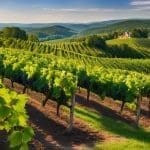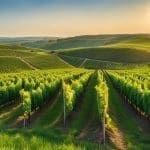If you’ve got a taste for zesty and aromatic whites, let me take you on a virtual jaunt to Galicia – the lush, undulating corner of Northwest Spain renowned for its exquisite Galician wine. This region is especially famous for its Spanish Albariño, a grape variety that’s become synonymous with sun-soaked relaxation and convivial sips around the globe.
My visits to the vineyards here are more than just a feast for the senses; they’re an exploration into a viticultural heritage that’s blossomed dramatically. From the dew-drop mornings perfect for wine tasting to the friendly wine tours pulsating with passion, every moment is a story unfurling among the vines. And, trust me, a vineyard visit in this stunning landscape, draped in verdure and tradition, is not one you’ll soon forget.
It’s my pleasure to share with you not just the notes of peach and apricot from the Albariño or the wine itself but also the enchanting tales and endeavours that blanket these historic vineyards. So, pull up a chair, grab a glass, and let’s delve into the world of Galician wines together.
Key Takeaways
- Galician wine, with its flagship being the zesty Spanish Albariño, is a must-try for white wine aficionados.
- Vineyard visits in Galicia offer an immersive insight into the region’s winemaking traditions and modern innovations.
- Discover the beauty of the Rías Baixas region during wine tours designed to unravel the secrets of its lauded viticulture.
- Engage in wine tasting experiences to truly appreciate the variety and complexity of Galicia’s wine offerings.
- Experience the rich terroir and maritime climate which shape the unique profile of Galician wines.
An Introduction to Galician Wine and Its Heritage
Embarking on a voyage through time, the Galician wine narrative commences with the Romans and flourishes under the nurturing hands of 12th-century monks. It’s a rich tapestry of history and taste, where each sip is a testament to Galicia’s profound wine heritage. I’m captivated by the array of indigenous grape varieties, each contributing its own stanza to the region’s vinous song.
The quintessential Spanish Albariño, hailing from Rías Baixas, makes a grand entrance with its light and fragrant persona yet engages with a complexity rivalling the finest white Burgundies. But Albariño is not a solo performer; the ensemble includes Godello, Treixadura, and Loureiro—each playing a vital role in the white wine symphony. Reds, such as Mencía, Caiño Tinto, and Espadeiro, offer a deeper tone to this harmonious arrangement, creating wines that are profound yet spirited.
| Wine Region | Notable Varieties | Characteristic Profiles |
|---|---|---|
| Rías Baixas | Spanish Albariño | Acidic, Mineral-Driven, Fruity Undertones |
| Ribeiro | Treixadura, Godello | Complex, Flavorful, Blends Well |
| Ribeira Sacra | Mencía | Elegant, Aromatic, Lightly Mineral |
| Valdeorras | Godello | Rich, Full-Bodied, Burgundy-like Complexity |
| Monterrei | Caiño Tinto, Espadeiro | Vibrant, Fresh, Youthful |
Exploring these heritage-rich zones through wine tours not only educates the palate but also tells a story of survival, identity, and passion. Galician wines, with their refreshing acidity and intriguing mineral notes, invite you on a journey that intertwines history and modern marvels. Come, let’s toast to Galicia’s vibrant viticulture—celebrating not just a beverage but the very soul of Spain’s verdant northwest.
Exploring the Terroir: Climate and Geography’s Impact on Galician Wines
As a wine enthusiast, my travels to the Galician region revealed to me just how intimately climate and geography can influence the taste and aroma of a wine. In Galicia, the interaction between the rugged landscape and the climatic conditions crafts a terroir that is as complex as it is fascinating, making every sip of Galician wine a tribute to its natural heritage.
The Humidity and Sunshine Balance
While savouring the crisp, refreshing notes of a Spanish Albariño during a recent vineyard visit, the winemaker explained how Galicia’s climate, marked by a balancing act of high humidity and ample sunshine, shapes the character of Galician wines. More than 50 inches of rain yearly and over 2000 sunshine hours create an environment that nurtures the grapes, endowing them with a unique profile that could only be described as the essence of Galician terroir.
The Influence of Granite and Slate Soils
During the same vineyard visits, I learned that Galicia is like a patchwork of soils, each contributing its voice to the chorus of Galician wine flavours. The granitic sands of the Rías Baixas region provide excellent drainage, which is optimal for cultivating the famed Albariño grape. Conversely, in Valdeorras, slate soils with their heat-retaining properties give Godello wines a boldness and an intensity that resonate with any wine tasting aficionado’s palate.
Without a doubt, the dynamic Galician climate and varied terroirs offer a master class in viticulture, making every glass of Galician wine, especially the sought-after Spanish Albariño, an exploration of geography’s remarkable impact on wine.
Galician Wine Varietals and Their Styles
Embarking on a wine tour through Galicia is akin to delving into a storybook of enchanting flavours. At the heart of this narrative is the Spanish Albariño, a grape varietal synonymous with the Galician wine identity. As I’ve ventured through vineyard visits, I’ve come to appreciate the subtle complexities and profound expressions of this flagship grape.
Albariño: A Flagship Grape
Renowned for its fragrant bouquet and zesty palate, Albariño reigns from the Rías Baixas DO, where the Atlantic’s influence weaves through vineyards, bestowing a sapid minerality upon each grape. Wine tasting sessions reveal a world where fruit and sea merge, yielding dry wines that carry the essence of Galician wine in every sip. A visit to a Galician vineyard often ends with a glass of Albariño, celebrated for a luscious depth balanced by a refreshing acidity.
Discovering Other White and Red Grapes
Beyond the illustrious Spanish Albariño, Galicia’s vinous mosaic brims with other varietals shaping its wine tapestry. The Godello grape, with its whispers of Burgundian nobility, imparts an elegant complexity, while Treixadura adds a structural backbone to sublime blends. On the red spectrum, the perfumed Mencía varietal unveils an aromatic elegance, crafting wines that are as captivating as the lush Galician landscape. And as I’ve wandered through rustic vineyard visits, encountering the likes of Caiño Tinto and Espadeiro has introduced me to zesty acidity and invigorating lightness, respectively — each sip a testament to the diversity that thrives within Galicia’s vine-studded terrain.
Wrapping Up Our Journey Through Galicia’s Viticultural Gems
As I reflect on the vinous journey across Galicia, I’m captivated by the rich tapestry of Galician wine culture that thrives in this lush corner of Spain. The famed Spanish Albariño, with its crisp and aromatic profile, stands as a beacon of Galicia’s winemaking excellence, yet it’s the medley of indigenous grape varieties that truly embodies the region’s viticultural diversity. Each varietal tells a part of Galicia’s storied past, translating the essence of its unique heritage and favourable maritime climate into each bottle shared and savoured.
Immersive wine tours and wine tasting experiences await those eager to explore Galicia’s vinous offerings, where the majesty of wine making comes alive with every vineyard visit. To swirl, sniff, and sip Galician wine is to partake in an age-old tradition steeped in personal dedication and environmental influence – a sensory journey not just of taste but of time and place. I’ve taken delight in the discovery of each wine’s nuanced chapters, feeling ever inspired by the natural alchemy that transforms simple grapes into complex masterpieces.
Whether you’re a wine aficionado or a curious traveller, the Galician wine country is an enchanting destination. From its captivating landscapes to the intricate dance of climate and terroir, this region is a treasure that continues to yield exquisite wine expressions, affirming its standing within Spain’s illustrious winemaking narrative. So next time you pour a glass of that radiant Albariño, pause for a moment to cherish the history, the passion, and the journey encapsulated within its golden hues.
FAQ
What makes Galician wine unique?
Galician wine, particularly famous for its Spanish Albariño, stands out due to its unique maritime climate, distinctive soil composition with granite and slate, and the traditional winemaking practices of the region. The local varietals cultivated here, influenced by high humidity and ample sunshine, result in wines with remarkable acidity, minerality, and aromatic profiles that are truly unique to this verdant corner of Spain.
Can I visit vineyards in the Galician wine region?
Absolutely, you can enjoy vineyard visits across Galicia, where you’ll experience first-hand the beautiful landscapes and get an insightful look into the production of these unique wines. Wine tours often include guided trips to the vineyards, comprehensive wine tasting sessions, and conversations with the winemakers, providing an immersive experience into the world of Spanish Albariño and other local varietals.
What is Spanish Albariño and how does it taste?
Spanish Albariño is a white wine grape variety primarily grown in the Rías Baixas DO of Galicia. It produces a dry style wine, typically with a minimum of 12% alcohol content. Albariño wines are known for their fragrant, fruity attributes, with floral aromas, and a palate that includes mineral and salty notes, often compared to a refreshing sea breeze. Its vibrant acidity makes it a perfect pairing for seafood and a favourite among white wine enthusiasts.
Are there any other grape varieties in Galicia besides Albariño?
Yes, aside from the celebrated Albariño, Galicia is home to an array of other wonderful white and red grape varieties. These include Godello, which offers complexity and depth, Treixadura, known for adding structure to blends, and Loureira. Red grape varieties such as Mencía provide aromatic and elegant wines, while indigenous grapes like Caiño Tinto and Espadeiro contribute to the diverse wine profile of the region.
What should I expect from a wine tour in Galicia?
On a wine tour in Galicia, expect to be delighted by not only the charm of the vineyards and wineries but also by the opportunity to taste a diverse range of wines that Galicia offers. You will learn about the wine-making process, the impact of the region’s climate and terroir on the wines, and you’ll likely have the chance to meet the talented winemakers. Prepare your palate for a bounty of flavours, from light and fragrant wines to complex ones similar to white Burgundy in their depth and finesse.
How has the wine heritage of Galicia evolved over time?
The wine heritage of Galicia has ancient roots, dating back to Roman times, and received a significant boost from the monasteries in the 12th century. With the influx of EU assistance post-1986, there has been a renaissance in Galician winemaking, modernizing vineyards and wineries while keeping traditional techniques alive. The revival has led to an increased international reputation, particularly for regions like Monterrei, and the prominent rise of Spanish Albariño as a world-class wine.
What type of climate does Galicia have, and how does it influence the wine?
Galicia has a distinctive maritime climate characterized by its high humidity, resultant from more than 50 inches of annual rainfall, and a substantial amount of sunshine with around 2000 hours per year. This climatic balance, coupled with the moisture from the Atlantic Ocean and the shelter provided by local geographic features like the Miño river and Serra dos Ancares, leads to the production of wines that are acidic, mineral-driven, and bear a unique freshness.
Can I find robust red wines in Galicia, or is it all about white wines?
While Galicia is famed for its white wines, particularly the Spanish Albariño, there are indeed robust red wines being produced in this region as well. The Mencía grape, for example, creates red wines that are aromatic, structured, and can have a complexity that ages well. Though these reds may not be as widely known as Galicia’s whites, they are definitely worth exploring during your vineyard visits and wine tastings for a complete picture of Galicia’s wine diversity.
Source Links
- https://vinepair.com/articles/galicia-spain-definitive-guide/
- https://en.wikipedia.org/wiki/Galician_wine
- https://www.jancisrobinson.com/learn/wine-regions/spain/galicia
Sip smarter, subscribe now!
Subscribe for gourmet tips, event updates, travel ideas, and a free e-book on Food Pairings. Start your journey to culinary and travel excellence!















